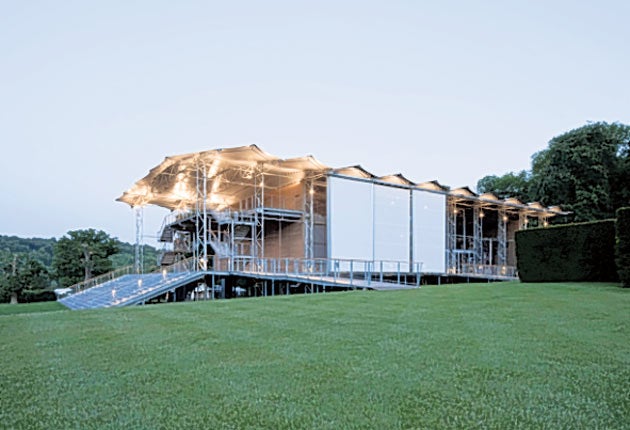Stripped-down stage is right on song
Garsington Opera has a new home, a flatpack pavilion that leaves all the frills to the performers who will grace it.

Looking north across the millionaire Mark Getty's 2,500 acre Wormsley Park estate in Buckinghamshire is to encounter an almost perfectly sylvan scene. The grass gleams as the breeze combs through it and, beyond a thatched Tudorbethan scoreboard, the cricket pitch has precisely the same dimensions as the Oval. The setting lacks only a soundtrack – Vaughan Williams's "Lark Ascending" would do.
But the only things ascending here on a bright day on the cusp of summer are riggers. They're fidgeting massive inflatable acoustic pillows like windsurfing sails into position along the sides of a glinting, delicate-looking steel structure. They barely notice what's beneath them: a stage, orchestra pit, sliding perimeter screens, and bare raked steps waiting to receive the 600 seats which are being forklifted into the backstage area.
This is the new home of Garsington Opera, which originally aria'd into life on 10 June 1989 with a performance of The Marriage of Figaro at Garsington Manor, 17 miles northwest of Wormsley Park. The privately funded opera company was considered to be a radical example of the regional cultural revolution.
Garsington's new opera stage and auditorium, designed by Robin Snell, is just as revolutionary. The architect describes the structure as a pavilion, but the building, designed to be erected and taken down in three weeks at the beginning and end of Garsington's annual summer seasons without wrecking Mr Getty's turf, has more than a whiff of Glastonbury or the Latitude Festival about it. This place would suit Lady Gaga as much as Sophie Bevan, who will sing here as Pamina in The Magic Flute on the first night on Thursday.
Conceptually, says Snell, it's a Japanese pavilion. He asks us to think Katsura Palace, shoji screens, and the hanamichi stages used in Kabuki theatre. Walter Gropius, Le Corbusier, Bruno Taut and Frank Lloyd Wright mined ideas from the same rich seam of oriental precedent.
The first thing Snell did was to align the building perfectly. From the pavilion's north-facing champagne bar verandah and the wide steps that cascade down from it, opera goers can take in the charming collection of small buildings that make up Home Farm, as well as the cricket pitch and the lake. The building is flanked with elevated side terraces which create a promenade around the structure. The forestage and backstage sit on the upper shelf of a ha-ha: Snell realised immediately that the 2.5-metre drop on the north edge of the ha-ha would give him an orchestra pit that required no digging out. As for the acoustics, Snell's sound consultant, Bob Essert, is confident that the inflated sails, sliding side-screens, and the precisely peaked and spaced riffles of the plastic roof covering will deliver the goods.
Snell's structure, which cost £1.7m, is practically flatpack Ikea; some of Garsington's patrons will wonder if this is architecture, or a glorified lighting rig with seats. Remarkably, it was entirely paid for by supporters who managed to raise virtually all of the £3m required for the move from Garsington Manor in about two years.
And so it is not a criticism to say that Snell's structure is anything but svelte in its details. The external handrails waver crookedly here and there; the welding of the short angle-pieces that zig and zag up the skinny pillars is brusque.
Ultimately, though, Snell's task was to design a pavilion that was as lightweight as possible; which demanded a visually porous structure that would keep out flurries of summer wind and rain. In this, he has succeeded. This is a virtuous, rather than virtuoso design, because the building makes no attempt to look anything other than temporary. Everything is simple. It is not eye-candy, but a lesson in practicality, on politely borrowed turf. "So when it goes at the end of the summer," says Snell, "you see nothing, and the deer come back."
The season opens on 2 June and runs to 5 July (www.garsingtonopera.org)
Subscribe to Independent Premium to bookmark this article
Want to bookmark your favourite articles and stories to read or reference later? Start your Independent Premium subscription today.

Join our commenting forum
Join thought-provoking conversations, follow other Independent readers and see their replies